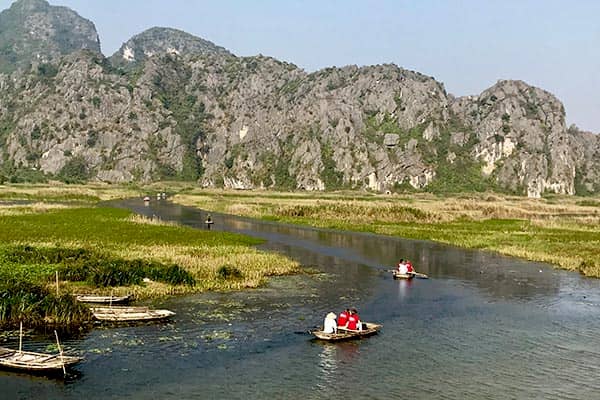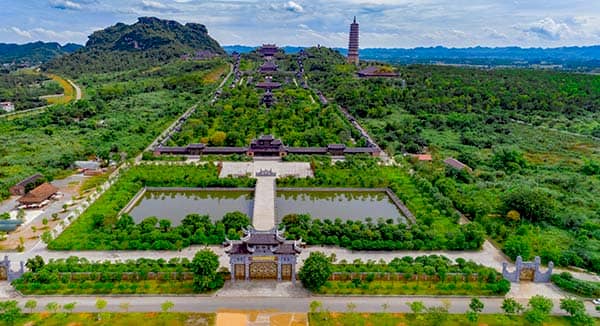NINH BINH - NORTHERN VIETNAM
TO DISCOVER THE INCREDIBLE LAND HALONG BAY
Located in the Red River Delta, Ninh Binh is also known as "Land Halong Bay" and is one of the 4 most visited destinations in Northern Vietnam.
In
addition to hosting the Trang An landscape complex (a UNESCO World Heritage
Site), Ninh Binh is also known for its scenes from the films Indochine (with
Catherine Deneuve) and Kong: Skull Island.
History of Ninh Binh
Ninh Binh was the capital of the country for 42 years, 13 years under the Dinh (968-980) and 29 years under the Le (980-1009). Visit the temples dedicated to the Dinh kings and immerse yourself in the history of the destination but also in its architecture, with remains dating back to the 17th century.
The temple dedicated to King Dinh (Dinh Tien Hoang, 924-979) is located in Truong Yên commune, Hoa Lu district (a former capital of Vietnam built after the country's reunification). It is used to commemorate King Dinh (who became king in 968) as well as his sons and parents. The temple is established within a 5 hectare enclosure. It is surrounded by century-old trees, ornamental plants and fruit trees.
This temple, one of the most beautiful remains of Hoa Lu, is an original work, thanks in particular to the remarkable 17th century wood and stone sculptures. Its architecture follows the shape of the Chinese characters. The temple contains several sanctuaries (one of which is dedicated to the worship of the King's parents). While visiting the temple, one can also admire a statue of King Dinh (in the central room), the royal bed, stelae, sculptures representing the dragon and the nghe (which are sacred figures), rare objects preserved,...
The temple dedicated to Emperor Le Dai Hanh is located 300m north of Dinh Tien Hoang Temple. It is built on the site of the former royal palace of Hoa Lu. Also called Ha temple, it is located like the temple of Dinh Tien Hoang.
In
this temple we can find the statue of Emperor Le Dai Hành (941-1005), as well
as that of Empress Duong Van Nga and that of her fifth son Le Ngoa Trieu, who
was the third and last emperor of the previous Le dynasty. This temple is lower
than that of Emperor Dinh Tien Hoang but it is more decorated, despite the same
traditional style, with a splendid interior decoration.
What to do in Ninh Binh?
Ninh Binh is a unique destination in Northern Vietnam, with its limestone peaks surrounded by rice fields and winding rivers. At the end of the Red River Delta region, there are many rivers whose water reflects the images of the peaks. If the region was once occupied by Hoa Lu, a former capital of Vietnam, it is now a peaceful, relaxing and peaceful place in the heart of Northern Vietnam.
In
addition to the visits to the historic sites mentioned above, the main activity
in Ninh Binh is boating or cycling.
Boat
trip
Boat trips in Ninh Binh on the rivers are an essential attraction of the destination. To carry out a walk of this type, several places are possible.
In Trang An, you can walk along the lotuses and water lilies, while crossing several caves.
In Tam Coc, in addition to being able to admire the rice fields, we notice that the guides and rowers have the particularity of rowing with their feet.
In Van Long, you can discover different fascinating animal and plant species in the forests, caves and waters (white langurs, catfish, birds,...).
All these walks allow you to discover landscapes that are all more impressive than the others and offer wide panoramic views of nature and its incredible beauty. A magical stopover during your trip to Vietnam.

Boat trip to Tam Coc
Bike
ride
Boats are not the only means of transport available to walk and enjoy the calm, you can also discover Ninh Binh by bike. The roads are very accessible and the terrain is flat, which makes it easy to move around while enjoying the landscape, the large mountains and rice fields.
Finally,
in addition to the temples, it is also possible to visit other very interesting
places.
Pagodas
and cathedrals
One example is Phat Diem Cathedral, which is 30 km from the city of Ninh Binh and is the largest Catholic architectural complex in Vietnam. With an osmosis between the architecture of Western cathedrals and that of Eastern pagodas and temples, this is one of the few examples of Sino-Gothic architecture in the world.
Bich Dong Pagoda is also worth a visit. It is composed of three pagodas named according to their position: Lower pagoda (Ha), Middle pagoda (Trung) and Upper pagoda (Thuong). The Upper Pagoda is not very difficult to reach and offers a very beautiful view.
Located 15km from the city of Ninh Binh and west of the ancient capital Hoa Lu, Bai Dinh Pagoda is a complex of Buddhist temples that includes the new pagoda (with buildings built only a few years ago) and the old pagoda.
The old pagoda is located on Mount Dinh. It has a main sanctuary with two caves. On the right, the cave Sang (Light) honours Buddha Sakyamuni, while on the left, the cave Toi (Dark) honours the Mother Goddess. Built in a cave (which is recurrent for old Vietnamese pagodas), it was the place where Emperor Dinh Tien Hoang organized the Sacrifice to Heaven and Earth ceremony. On the central face of the Blood Cave, it is possible to admire four giant ideograms, while on the altar, traditional statues representing the Buddhas of the past, present and future are present. Finally, an outing to the bottom offers a magnificent view of the valley below.

Bai Dinh Pagoda in Ninh Binh
The new pagoda of Bai Dinh holds several records, such as:
- The longest corridor of a Buddhist pagoda (3km of corridor).
- The largest number of statues of Arhat (in ancient Buddhism: the highest stage in religious progression) in Vietnam: 500 statues are present in the corridor, each measuring between 2m and 2.50m for 2 to 2.5 tons and representing man's state of mind: joy, anger.
- The temple exhibiting the 3 statues of the largest Buddhas in Vietnam (the temple of the three Buddhas).
Don't
miss it on your trip to Vietnam.



